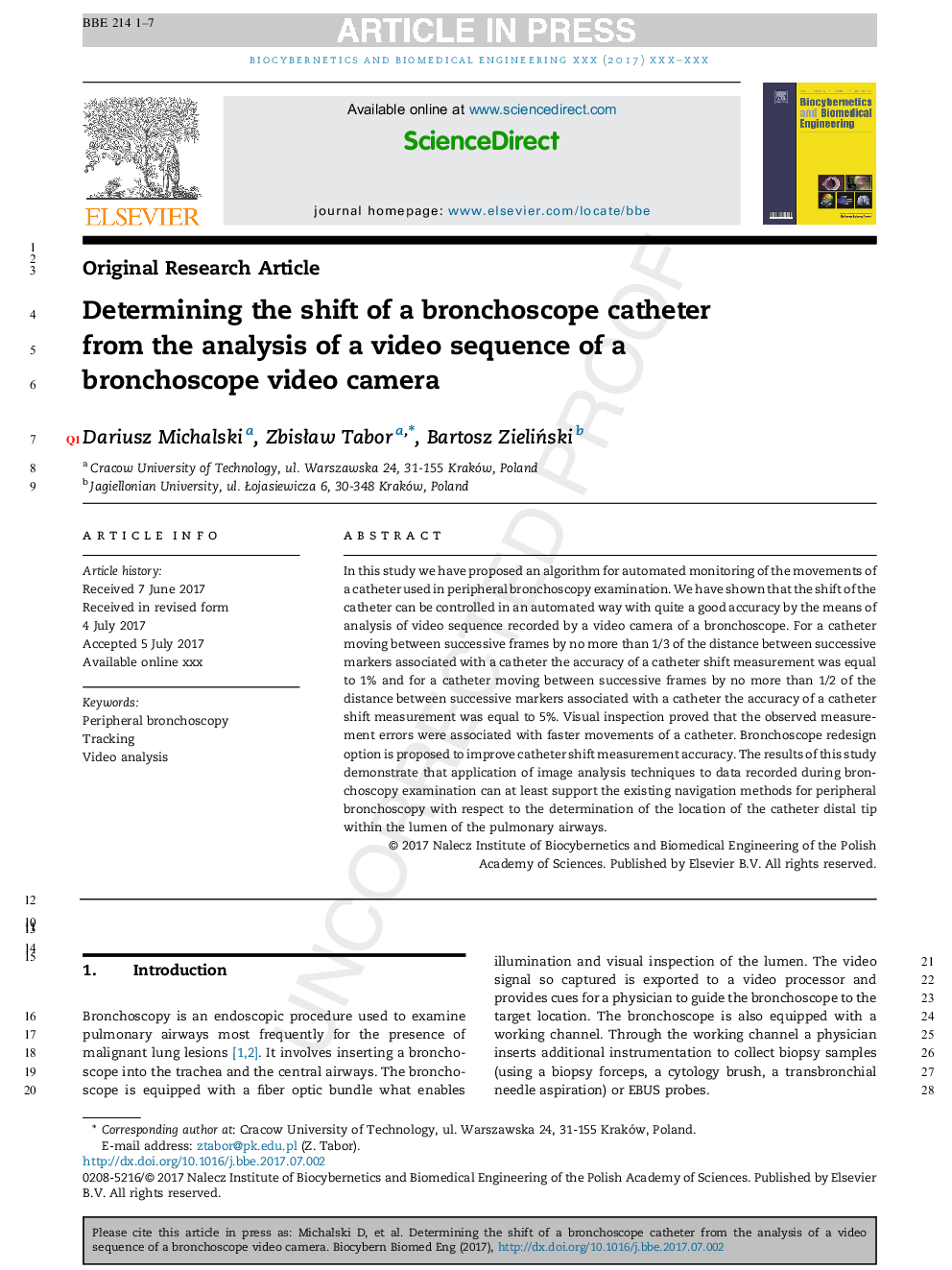| کد مقاله | کد نشریه | سال انتشار | مقاله انگلیسی | نسخه تمام متن |
|---|---|---|---|---|
| 6484192 | 1416075 | 2017 | 7 صفحه PDF | دانلود رایگان |
عنوان انگلیسی مقاله ISI
Determining the shift of a bronchoscope catheter from the analysis of a video sequence of a bronchoscope video camera
ترجمه فارسی عنوان
تعیین تغییر کاتتر برونکوسکوپ از تجزیه و تحلیل یک ترتیب تصویربرداری از یک دوربین برونکوسکوپ
دانلود مقاله + سفارش ترجمه
دانلود مقاله ISI انگلیسی
رایگان برای ایرانیان
کلمات کلیدی
برونکوسکوپی محیطی، ردیابی، تجزیه و تحلیل ویدئو،
ترجمه چکیده
در این مطالعه الگوریتمی برای نظارت خودکار حرکات کاتتر مورد استفاده در آزمایش برونکوسکوپی محیطی پیشنهاد شده است. ما نشان داده ایم که تغییر کاتتر را می توان با یک روش خودکار با دقت بسیار خوب توسط روش تجزیه و تحلیل توالی ویدئو ثبت شده توسط یک دوربین ویدئویی از برونکوسکوپ کنترل کرد. برای یک کاتتر در حال حرکت بین فریم های متوالی با بیش از 1/3 فاصله بین نشانگرهای پیوندی مرتبط با یک کاتتر، دقت اندازه گیری تغییر کاتتر برابر با 1٪ بود و برای کاتتر در بین فریم های متوالی با بیش از 1 / 2 فاصله از بین نشانگرهای پیوندی مرتبط با کاتتر، دقت اندازه گیری تغییر کاتتر 5٪ بود. بازرسی بصری ثابت کرد که اشتباهات اندازه گیری مشاهده شده با حرکت سریعتر کاتتر همراه بود. گزینه تجدید ساختار برونکوسکوپ برای بهبود دقت اندازه گیری تغییر سوند پیشنهاد شده است. نتایج این مطالعه نشان می دهد که استفاده از تکنیک های تجزیه و تحلیل تصویر به داده های ثبت شده در معاینه برونکوسکوپی می تواند حداقل از روش های ناوبری موجود برای برونکوسکوپی محیطی با توجه به تعیین محل نوک دفاعی کاتتر در لومن راه های هوایی ریه حمایت کند.
موضوعات مرتبط
مهندسی و علوم پایه
مهندسی شیمی
بیو مهندسی (مهندسی زیستی)
چکیده انگلیسی
In this study we have proposed an algorithm for automated monitoring of the movements of a catheter used in peripheral bronchoscopy examination. We have shown that the shift of the catheter can be controlled in an automated way with quite a good accuracy by the means of analysis of video sequence recorded by a video camera of a bronchoscope. For a catheter moving between successive frames by no more than 1/3 of the distance between successive markers associated with a catheter the accuracy of a catheter shift measurement was equal to 1% and for a catheter moving between successive frames by no more than 1/2 of the distance between successive markers associated with a catheter the accuracy of a catheter shift measurement was equal to 5%. Visual inspection proved that the observed measurement errors were associated with faster movements of a catheter. Bronchoscope redesign option is proposed to improve catheter shift measurement accuracy. The results of this study demonstrate that application of image analysis techniques to data recorded during bronchoscopy examination can at least support the existing navigation methods for peripheral bronchoscopy with respect to the determination of the location of the catheter distal tip within the lumen of the pulmonary airways.
ناشر
Database: Elsevier - ScienceDirect (ساینس دایرکت)
Journal: Biocybernetics and Biomedical Engineering - Volume 37, Issue 4, 2017, Pages 630-636
Journal: Biocybernetics and Biomedical Engineering - Volume 37, Issue 4, 2017, Pages 630-636
نویسندگان
Dariusz Michalski, ZbisÅaw Tabor, Bartosz ZieliÅski,
